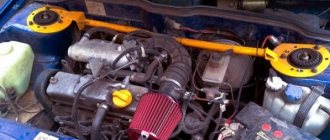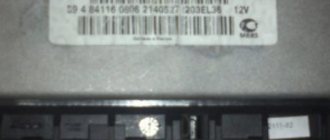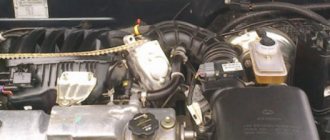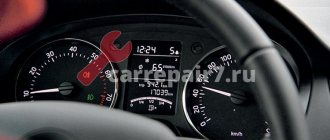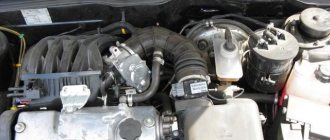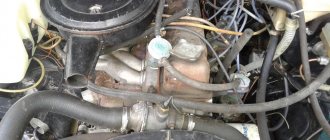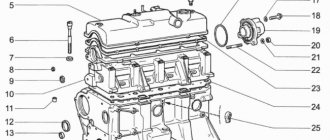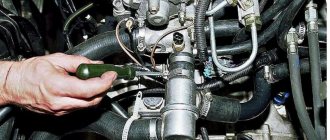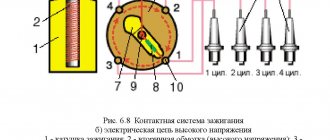Disadvantages of e-gas
- A slight dullness at start (engine responsiveness) becomes slower by about half a second. It is treated by installing a spur.
- Lack of deep tuning capabilities. To get serious about it, you will have to get rid of such a pedal and switch to a regular cable. (The cost of the alterations is approximately 20 thousand rubles: brains, sensors, wiring, pedal). True, now they are slowly learning how to do firmware, configure turbo engines and compressors. The future, naturally, belongs to electronics.
- Problems often occur on the first models.
Problems associated with e-gas
As mentioned above, the first models encountered common problems:
- the revolutions were floating;
- pedal stuck;
- the car was accelerating itself.
Important! AvtoVAZ has issued an information letter that talks about the need to adapt e-gas after replacing the controller or removing the battery: how to adapt?
Diagnosing and eliminating error p2125
It takes a little time to diagnose the problem. The reason for error p2135 on the VAZ 2114 may be as follows:
- Electrical wiring fault;
- Throttle position sensor malfunction.
To work you need the following:
- Tester (voltmeter and ohmmeter);
- Crosshead screwdriver;
- A pair of needles.
DPDZ VAZ2114
First of all, remove the electrical connector from the sensor. There will be three slots on the chip. It is necessary to determine the purpose of the contacts. At the same time, the integrity of the electrical wiring is checked:
- The voltmeter is set to the measurement limit of 20V;
- Turn on the ignition;
- The positive probe is connected to the positive terminal of the battery;
- Look for the contact of the wiring connector, which will have a reading equal to the battery voltage (12V). This will be the ground contact;
- Connect the negative probe of the voltmeter to the ground contact and look for a contact with a voltage of 5V. This will be the supply contact;
- The remaining terminal is a signal terminal, the voltage at which, when the sensor is connected, must correspond to the current position of the damper.
Connecting a voltmeter
If the indicated voltages differ to a lesser extent, then there is a fault in the electrical wiring.
The remaining actions are performed with the sensor connected:
- In order not to cut the wires, they pierce the insulation of the ground and signal wires with needles and connect them to the voltmeter probes;
- By changing the position of the throttle valve (with the gas pedal or manually with the throttle assembly removed), monitor the voltmeter readings. The voltmeter should show 2-1.5V when the damper is closed and 5V when open. The readings should change smoothly, without jerking.
You can check the sensor with an ohmmeter with the connector removed. One of the probes is connected to the signal terminal, and the second to any of the remaining ones. When moving the throttle valve, the readings should vary from several hundred ohms to 2500-3000 ohms .
It is convenient to use a pointer instrument, since jump-like measurements of parameters are clearly visible in it.
Sensor location
A sensor whose measurement parameters change abruptly must be replaced. To remove, unscrew two screws with a Phillips screwdriver and install a new sensor. After this procedure, error p2135 VAZ 2114 should disappear. You may have to remove the terminals from the battery for a few minutes to force the error to reset. If the check does not stop lighting, then the error must be reset using a diagnostic scanner, for example ELM 3.
How does e-gas work?
It consists of 3 elements: an electronic damper, a sensor, and the pedal itself.
The sensor takes into account the degree to which the driver presses the pedal and transmits the data to the ECU, which sends a signal to the electric damper, which opens the way for air to enter the engine. Also, in cars with such a pedal, a frequency-type air flow sensor is used.
It is powered separately to the ECU. In case of the slightest voltage deviations from the norm, errors appear: (P2122-P2123, P2127-P2128, P2138).
Source
How to remove the idle speed sensor
Replacing the idle air control valve on a VAZ is very simple
To remove the sensor, you need to put the car on the handbrake and disconnect the negative terminal from the battery. Next, you need to disconnect the wiring harness from the sensor and clean the place where the IAC connects to the throttle pipe body - so that dirt and sand do not get into the mounting hole. The sensor is secured with two screws, which must be unscrewed with a screwdriver or ratchet.
Mechanical and electronic pedal
But first, let’s talk about why it was necessary to remake an old, reliable system that works without interruptions. There are several reasons for this.
When controlling the throttle position directly with your foot using a cable, there is a slight delay between opening the valve and adjusting the mixture, this leads to the following consequences:
- the wrong mixture produces a large amount of C02;
- non-compliance with EURO-5 and EURO-4 standards;
- when the gas pedal was fully pressed, much more fuel was consumed than necessary, which increases the overall consumption;
- direct control of the mixture by a person leads to the possibility of operating the internal combustion engine in critical modes at high speeds or changing the mixture too sharply, which negatively affects the service life of the engine.
In order to avoid these problems, engineers decided to protect human access to direct control of engine operating modes; in the VAZ 2114 with e-gas, the throttle valve is controlled by the ECU, taking into account the position of the gas pedal, but not 100% subordinate to it.
- uniform opening of the throttle valve, without jerking;
- synchronous change in the composition of the mixture and opening of the damper;
- saving fuel and increasing engine life;
- possibility of installing anti-skid and traction control systems.
In theory, everything looks great and all the changes seem only for the better. But the electronic gas pedal of the VAZ 2114 has problems that appear because during production the device was not sufficiently tested and a crude product was released onto the market.
↑ Carburetor adjustment
When pedal 16 is fully pressed, the throttle valve of the first chamber should be completely open and the throttle lever should not have additional travel. When the pedal is released, the throttle valve should be completely closed. If this is not the case, then the position of the pedal and the throttle valve can be coordinated by changing the length of rod 8, rolling or screwing its tip.
At the same time, check and, if necessary, adjust the length of rod 6. The center-to-center distance of its tips should be 80 mm.
The rod 3 of the air damper drive and its shell must be secured so that when the handle 1 is fully extended, the air damper is completely closed, and when the handle is recessed, it is completely open.
Sooner or later, every car enthusiast operating domestic VAZ cars is faced with a situation in which fuel consumption increases significantly. Often the process of increasing fuel consumption is accompanied by unstable engine operation. A non-original, but quite reasonable question arises: “What to do?”
There are several solutions to this problem. Some car owners prefer to eliminate the problem with the help of specialized car service personnel equipped with modern equipment: a gas analyzer, a stand, etc. However, for some it is expensive or time consuming, while for others it is simply not interesting. It is for this category of domestic car enthusiasts that this article-instruction was created on how to set up the VAZ 2106 (VAZ 2107) carburetor yourself.
E-gas VAZ 2114 problems
Often the main disadvantages of electronic gas are these aspects:
- Delay in the car's response to pressing the accelerator pedal.
- Problems with floating speed, gas sticking and self-actuating.
- Impossibility of quick car tuning.
The delay is formed due to the fact that the signal from the pedal is first transmitted to the ECU and only after processing, the electric drive on the damper begins to smoothly change its position. In newer cars, this delay has been reduced thanks to better software and faster hardware. The e-gas equipment of the VAZ 2114 can also be reflashed, increasing the power and pedal response speed, but lowering the environmental standard to EURO-2.
What causes error p2135?
Structurally, the VAZ2114 throttle position sensor is a variable resistor, the moving contact of which is connected to the throttle valve axis. The presence of mechanical contact between the slider and the conductive layer leads to the fact that the reason for the appearance of error 2135 on the VAZ 2114 most often lies in a sensor malfunction.
Less often, an error occurs due to the fault of electrical wiring. In particular, moisture entering the contacts of the sensor connector causes them to oxidize and increase the contact resistance. Poor ground contact and broken or shorted wires may also occur.
E-gas malfunctions
Sometimes the cause of malfunctions is a breakdown of the idle speed sensor on a VAZ 2114 with an electronic gas pedal, also called IAC. If the ECU indicates an error and the engine idle speed is too high and does not drop, mostly 2000, then the throttle assembly needs to be replaced, or you can try cleaning the terminal contacts.
If the electronic pedal is faulty and does not respond to pressing the accelerator pedal, and the engine speed is frozen at around 2000 rpm, do not despair and call a tow truck. With such a problem, you can move around, carefully releasing the clutch, slowly but surely you can get to your home or service center.
If you have some kind of malfunction related to the electronic gas pedal, then in the control unit you will most likely be able to find the following error codes:
- P2122 - indicates low voltage of the accelerator pedal position sensor. This sensor works on the principle of changing its resistance, and the ECU, passing current through it, recognizes it and, based on this, knows the position of the pedal. Low voltage corresponds to high sensor resistance. This can be solved by cleaning the contacts, soldering them, or replacing the pedal assembly if that doesn’t help.
- 2123 is the reverse error P2122, the voltage on the same sensor is too high. A breakdown or short circuit in the wiring, as well as failure of the sensor, is possible.
- 2127 – low signal level of the second accelerator pedal position sensor. Since this unit is quite responsible and performs an important function, it uses two sensors for accuracy and reliability. They are located in the same building, the sequence and methods for eliminating the error are the same.
- 2128 is a clone of error code 2123, only it is responsible for the second sensor.
- 2138 - the code indicates a discrepancy in the readings of these two sensors; perhaps contact has been lost with one of them or it has broken down. To solve the problem, you also need to clean the contacts, check the wiring for serviceability and test the pedal itself. The test consists of measuring the resistance of both sensors in different pedal positions and comparing the readings. If they are different, you need to change the pedal assembly.
Nowadays, the electronic pedal has been worked on and most of the problems have been solved, now it works without failures, but fans of fast driving still flash their ECUs, noting improvements in the car’s response to the pedal.
This is primarily due to the fact that manufacturers are forced to impose restrictions from the factory in order to comply with EURO standards and increase engine life. Amateur firmware removes these restrictions, allowing the control unit to open the damper faster.
In Samara, and in particular with the electronic gas pedal of the VAZ 2114, problems were often encountered on models of the first years of production; after some time, the shortcomings were corrected and at the end of production, copies with reliable e-gas rolled off the assembly line.
Source
Problems and solutions
There are a lot of reasons for unstable idle, and they apply to both carburetor and injection engines and even diesel engines, both to the old type design and to the new E-gas pedal, which AvtoVAZ is so proud of. Let's start with the problems that occur in carburetor-type engines:
- The fuel-air mixture has become lean. To fix the problem, you just need to make an adjustment to the level of eight hundred revolutions.
- Unstable running can also occur due to wear on the carburetor valve. In this case, the engine operates exclusively with the choke mode extended. To fix the problem, you need to replace the defective part with a new one.
- It also happens that the system channels become dirty. Then the fuel does not receive the required portion of air and leads to failure. Here you just need to clean the channels.
In the injection type of engine, there are no fewer reasons for failure.
- The first thing you can check is air leaks. Be sure to check the connection between the intake manifold and the cylinders to see if the gaskets are worn out. There are rubber plugs on the same manifold; if they are cracked, it is better to replace them. You can check all this by buying carburetor cleaner or any other flammable item in the store, start the car and spray all the joints, if there is a leak, the car will start to twitch, look in that place.
- They can cause gaps in speed and malfunctions in the IAC sensor (idle air control), it is often enough to remove it and clean it or inspect it for damage and replace it if necessary.
- It would not be amiss to check the throttle assembly, since it is not the strong point of the fourteenth model. It is possible that the throttle valve is simply clogged, which causes failures in the entire system. Cleaning it is not at all difficult; this work can be done independently.
- Wear or contamination of spark plugs also affects idle speed, as well as the entire operation of the engine. This is perhaps the most quickly solvable problem that can be eliminated by replacing old spark plugs with new ones in five minutes.
But problems with electronic equipment, in particular the famous E-gas, are much more complicated. Here it is observed:
- regulator failure (IAC);
- DMRV sensor failure;
- failure of the EGR valve (adsorber);
- damage to wires.
The regulator is checked using a multimeter. If the device produces unacceptable values, above 80 Ohms, then you need to replace the regulator with a new one, since repairing it will be problematic.
If the regulator is normal, then you need to check the mass air flow sensor. The check is as follows: the connector is disconnected and the motor is turned on.
If the speed dynamics, at the initial one and a half thousand revolutions, increases, there is no doubt that the breakdown lies in the sensor. As practice shows, 80% of VAZ-2114 malfunctions lie in this part.
Unstable to long-term operation and EGR, which regulates exhaust gas emissions. When it fails, operation can be normalized by cleaning the valve.
And the last thing that should be checked is the condition of the air filters, which on the fourteenth get clogged quite often, and the ignition system itself.
So, we found out the reasons for the occurrence of unstable idle speed of the fourteenth VAZ model and learned methods for eliminating them. All that remains is to wish that your swallow works without failures and pleases you with excellent work!
No duplicates found
The viburnums had an electric pedal.
on the VAZ-2114 there is an electronic pedal.
Perhaps the author should correct it, not “from Granta” but “from 2010-2012”. VAZ 2113, also e-gas
Thanks for the addition, but it’s no longer possible to edit a long post (or I don’t know how).
Thank you for the excellent post, I would like to know how to adapt the pedal through a wire, I just adapted it mechanically, I didn’t feel the difference, VAZ 211340 2012 e-gas car. I have a laptop and a wiring harness (OBD2), I would appreciate any help.
The guy has a 2008 2114 with an electronic pedal.
Ecology is ecology, but the transition to an electronic accelerator pedal was largely due to the fact that the leader in the production of automotive electronics, Bosch, began in the 2000s to switch to a torque model of engine control in its ECUs. Instead of the usual and understandable OZ for fuel and correction, they began to introduce algorithms for optimal control of the ECU.
Regarding the reaction to the accelerator pedal, this problem was present in one way or another on all cars in the first generation of this system. Moreover, most of all they complained about the French. The Germans had this moment better worked out from the very beginning. And since 2005, it’s not possible to feel much of a difference.
As for our cars, the problems with the throttle were caused not by the environment, but by insufficient refinement and tuning. Because after VAZ and UAZ switched to Bosch 17.9.7 and analogues (to avoid a monopoly) in the form of M74, problems began to appear in commercial vehicles, with increased fuel consumption, sometimes with an immobilizer, with deterioration in performance. And in the first 3-4 months, people calmly opened the algorithms, completed them, configured them, and already offered normal solutions for chip tuning. Where no crutches in the form of boosters are needed.
Thank you for the clarification!
Good afternoon. The car is VAZ 211340 2012 e-gas. I will be glad for any help in solving problems to bring it back to normal. What firmware do you recommend, and how to flash it correctly.
I would recommend stock firmware first. Then figure out what doesn’t suit you. By the way, what’s not to like? if it’s a pedal, then you can install a regular throttle and change to firmware without e-gas
Everything is completely stock, nothing was changed, and if they were changed, it was with similar spare parts, there was no talk of tuning. The problem is with the speed, they float not bad. Also, the car may stall when I reverse. This is roughly what it looks like from the outside. I put it in reverse, squeeze the clutch, put it in neutral, slow down, the speed drops and as a result the car stalls. This happens not only in reverse gear. Usually before a traffic light. I slow down, depress the clutch, put it in neutral, slow down (the speed is around 2-7 km per hour, and the revolutions drop to 500, then sharply to 1200, and seem to return to normal. https://www.drive2.ru/b/921974/ there is a very funny letter from Auto Vase.
I quote: “On cars of the Lada Kalina family, equipped with an 8-valve engine, an electronic accelerator pedal and air conditioning, a possible place for the discrepancy to occur is “Speed up by 1500 - 2500 rpm at the time of gear shift to neutral” and “ Increase in engine speed when driving in neutral gear from 500 rpm to 1200 rpm.” To eliminate these inconsistencies, it is necessary to reprogram the ECM controller using the PB-6 programmer produced by NPP New Technological Systems, Samara (additionally, you need to purchase a cable for the M74 controller from NPP NTS, Samara), file I444CE08.hex .
In AGO, use defect code 1411020 000 008 “Reprogramming the controller with software I444CE06”, culprit 00001, labor intensity item 87088 – 0.3 n/hour. In the descriptive part of the AGO (field “Description of the defect”) and RA (in the column “Special notes on the complaint”), it is necessary to indicate the manifestation of non-compliance on the vehicle.”
That is, they openly say that everything is fine, don’t worry, just buy it and reflash it yourself. There are no problems with buying, but with reflashing, as if for the first time, I’m afraid to mess up. Maybe you can help me solve my problem.
E-Gas - what is it, what is it for and how does it work? Features of the electronic pedal
E-Gas (electronic gas pedal) is an electronic gas pedal that replaced the cable-operated throttle valve. Email The gas pedal controls the throttle electronically rather than physically. AvtoVAZ began producing models with E-Gas at the beginning of 2011, the reason was the environmental standards Euro-4 and Euro-5, which must be observed.
In this article you will learn what E-Gas is, how it works, why it was introduced, and what advantages and disadvantages it has.
↑ Carburetor control drive diagram 2107-1107010
1 — air damper control rod handle; 2 and 17 - seals; 3 — air damper drive rod; 4 and 14 — return springs; 5 — return spring fastening screw; 6 — transverse thrust; 7 — intermediate lever; 8 — longitudinal thrust; 9 — rod fastening bracket; 10 — bracket for mounting the roller; 11 and 13 — levers; 12 - roller; 15 — lock washer; 16 — throttle valve control pedal.
Why did AvtoVAZ need E-gas?
As I already said, environmental standards are becoming stricter every year, in order for the exhaust to comply with the standards, the cable had to be removed. This made it possible to get rid of the driver’s empty gasping, as well as other unnecessary actions that increase the toxicity of exhaust gases. The electronic pedal, as it were, regulates “at its own discretion” how to open the throttle. Even a sharp press on the pedal will be processed in such a way that as little harmful CO2 as possible is released into the atmosphere.
How it works?
An electronic pedal consists of three main elements: pedal, electric pedal. damper, as well as a sensor located on the pedal itself. The sensor reads the degree of pressure on the pedal, and then sends the data to the electronic unit. It receives the data, analyzes it and sends a signal to the electronic damper, which opens to the required degree.
What advantages does E-gas have for the motorist?
- First of all, the electronic pedal helps reduce fuel consumption.
- Despite the widespread belief that E-gas “presses” the engine, statistics show that electronics, on the contrary, improve dynamics. Although there is indeed a slight “stupidity” at the beginning.
Now about the disadvantages of E-gas
- Most often email. The pedal is criticized for its pause (“stupid”) at the start, when you press the pedal sharply and try to accelerate. According to many, the engine interacts poorly with the pedal, as a result of which approximately one second is lost. Although we have learned to correct this shortcoming.
- E-gas does not allow serious engine tuning, since the pedal negates all efforts. Installing a cable drive solves the problem. I would also like to note that we learned how to customize and customize the pedal for specific needs.
- The electronic pedal causes a lot of trouble during operation.
Is it possible to drive with this problem?
Despite the fact that the malfunction in question does not in any way affect the condition of the car, driving until the problem is fixed is strongly not recommended. Inadequate response to the gas pedal can easily provoke an accident. Imagine that you are overtaking and at that moment the traction suddenly disappears, and oncoming traffic appears ahead. Or before an intersection or pedestrian crossing, the car makes a jerk.
Considering that you can solve the problem yourself in the shortest possible time and with a minimum of costs, you should not delay repairs.
How to check the electronic gas pedal of Lada cars
In order to comply with modern environmental standards, AVTOVAZ equips all its Lada cars (Priora, Kalina, Granta, Largus, Niva 4x4, Vesta and XRAY) with an electronic gas pedal (E-gas). The gas pedal with a cable was abandoned in favor of electronic control. This replacement was not to the liking of many car enthusiasts, because... Problems occasionally occur with E-gas. We are learning how to test the electronic gas pedal.
Popular malfunctions of the electronic gas pedal:
- revolutions float;
- the engine does not feel the gas;
- pedal play.
To remove the E-gas pedal:
- Disconnect the block with wires next to the gas pedal;
- Unscrew three nuts using a 10mm wrench;
- Remove the gas pedal.
How to check E-gas (the condition of the moving contacts and conductive paths of the gas pedal position sensors):
- One multimeter probe (in ohmmeter mode) to terminal No. 4, and the other to terminal No. 2. Slowly moving the gas pedal, we control the electrical resistance, which should gradually decrease. We check conclusions No. 4 and No. 3 in the same way.
- We check the conductive path of the other sensor by connecting a multimeter to pins 1-6 and 6-5.
If, when checking any of the tracks, the resistance changes abruptly, then the E-gas pedal is faulty. If a malfunction is detected in the electronic gas pedal, it is not repaired, but replaced with a new one. When installing, tighten the nuts to 6-8 Nm.
A little about car idling
Idling refers to the operation of the power unit in a static position of the car, that is, when the car is stationary and the neutral gear is engaged.
When the engine operates this way, the load on it is negligible, and, therefore, fuel consumption is low. Idling is usually used to warm up the system in winter frosts in order to disperse the oil and prevent freezing. This mode is also used when it is impossible to turn off the motor.
During normal idling, the tachometer needle points to 2,000 rpm and slowly drops to eight hundred rpm. But, if there is a failure in the system, then the revolutions seem to live their own lives, sometimes soaring to incredible heights, sometimes falling to the very bottom.
In this case, the revolutions can fluctuate from a minimum of five hundred to a maximum of one and a half thousand revolutions per minute.
This happens especially often in new VAZ models equipped with an electronic pedal, E-gas, which, on the one hand, opens up new horizons for the driver, and on the other, gives him even more headaches in troubleshooting such fragile and unreliable electronic equipment.
It is worth saying that determining the true cause of an idle problem is not an easy process, but if you leave everything as is, it can lead to serious problems, which may result in a complete stop of the engine and the need for expensive repairs.
And now about all the problems and how to fix them in more detail.
E-gas (electronic gas pedal) and its adaptation
The first thing you need to do when buying this machine is change it (I flashed the software from Icebreaker) and everything works smoothly.
But there is one problem, e-gas is a rather delicate thing, if for some reason the car starts once on the 4th or 5th (for me this was caused by frosts of -30), then the operation of the e-gas is disrupted, resulting in floating rpm from 800 to 1000, or Even worse, the car will simply stall or idle at 2000 rpm.
Now let’s talk about how to cure this, that is, ADAPT E-GAS; there are sites to peel off, but there is no detailed description, I’ll share!
There are 2 ways to solve the problem:
- Find a good electrician and he will adapt you to e-gas for 1000-2000 rubles.
- Carry out the adaptation yourself!
I’ll tell you everything point by point, if you find that the speed has dropped after the engine has started, say, 5 times, then you need to:
- Not to worry.
- We turn off the car, remove the negative terminal and smoke for 3-4 minutes.
- We put the terminal back on, get into the car and turn the ignition key, the instruments turn on, the pump starts pumping gasoline, and we wait 40 seconds, after which we start the car! Most likely the situation will be the same! Getting ready for the most interesting things! Direct adaptation!
- The car is started, we drive out to a section of the road where we and no one will bother us!
- We get underway and engage second gear, press the gas pedal and spin up to 4000 rpm, and then release the gas pedal (that is, we brake the engine with the gear engaged) and wait for the rpm to drop to 1200-1000, and do the same thing 6 times.
- We park.
- We turn off the car.
- We remove the negative terminal, smoke again for 3-4 minutes, then put it back on.
- When you get into the car, insert the key, turn everything works, wait 40 seconds and start it!
The tachometer shows 800, nothing floats, the owner is happy!
I adapted my car in this way 3 times, I taught it to my friends, and they couldn’t be happier.
Source

